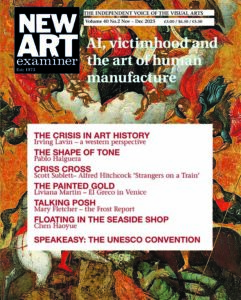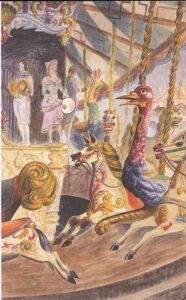

It’s 1995. I’m with my brother in Soho; I live five minutes away on Stanton St; he’s visiting from California. We’re walking past Broome Street warehouses washed by winter sun, that cold yellow light on white painted brick. We visit one gallery after another.
George says it feels like post-apocalyptic times. Money’s gone, the markets crashed, art world’s dead and we’re sifting through the ashes. We talked of Baldessari, his followers. Of the patronage system. Some of these galleries are fragments, histories, bread crumbs.
Aesthetics has a bad name in our time. Treated like a distant uncle who embarrassingly plagues our family gatherings, it’s seen as a weakness, leftover from patriarchal times when wives dragged their husbands to the opera.
At present the problem’s misunderstood, the players confused. In fact at a discussion in the School of Visual Arts in New York, a panel of critics, learned art historians, and respected professors could not define the term. The lecture’s theme (Crisis In Aesthetics) was referred to, drawn from, sketched lightly but never defined, as if unimportant. Aesthetics was unacceptable in 1995. One audience member suggested dispensing with aesthetics altogether, but that’s like hanging first, trial after …
I’d studied at Rochester’s Visual Studies Workshop and apprenticed at Afterimage. There I met Charles Desmarais, an intellectual white lab-coat curatorial student, mistrustful of intuition and passion, two qualities perhaps necessary for a gatekeeper of the arts. Charles later held influential posts, including director of New York’s International Center for Photography. Suffice to say that under his watch, photography transitioned into postmodernity, was renamed “a lens-based practice”, falling in status from an art form to “a tool for conceptual practice”. In 2011 Charles was president of the San Francisco Art Institute, a position he left in October 2015, but his influence remained. Five years later the Art Institute announced it was closing its doors after 150 years. Was that a hypertrophy of the intellect, this anti-aesthetic, counter-aesthetic?
Forward in time 22 years, New York like a bouncy ship on waves of art history. But California’s different… it’s warmer down there, and… Hollywood… and Joshua trees. In 1950s postwar era, poor Europe, ravaged and beaten, could not resist and fell under the onslaught of CIA dollars promoting Abstract Expressionism. Minerva the French art muse followed the money… landing in New York but continuing to sunshine California, where, ironically enough, superficiality subverted some of the most serious thinkers in the arts.
Susan Sontag writes in “Against Interpretation” of that hypertrophy of the intellect, of words being the revenge of the intellectual on the artist. Visual art uses a visual language, complex but non-verbal. Intellectual art is reduced without the integrated network of body language, acoustic language, and visual language; John Cage proved in 4’33” that ideas cannot replace art. That belief came from a flawed 1920 French theory on intellectual dominance, which had lain dormant but flared up in the 1960s.
SoCal was a bastion of conceptual art, a high risk proposition. Ideas live in words, they belong to literature, ideas are to write down, but everything changes during production. Certainly the idea’s influence is not as dominant in painting or video or any other media where it’s the medium that’s the message.
Alarm bells ring at Marshall McLuhan’s famed 1960s observations, often misattributed to Warhol, that art is anything you can get away with. If art is anything you can get away with, the worst you can get away with is always the best strategy. The personal advantage accruing to the player parallels a steady degradation of contemporary art. Such ethics suggest the arts pioneered a post-truth era which finds expression in today’s politics. Did postmodernism foster a cult of denial that now has taken presidential form? The canary in the mine is coughing.
If the medium is the message then visual art, just as music and dance, contain conversations within conversations; we experience patterns, sequences, bridges, opposition and harmonies, we feel melodic, periodic, or melancholic as the work moves us. Music is a language, an acoustic language, just as visual language and dance describes things, wonderful things whose subtlety is lost when put in words. Since the intellect is but one mode, that of verbal language, art touches another level when it includes that which cannot be explained.
Miklos Legrady
Volume 34 no 4 March/April 2020 pp 18-19


So relevant are these comments from Miklos Legrady even though they are depressing, but like the virus we have to hang on. Many say the virus will fundamentally change our society, certainly it has changed the art world, as it was turbo charged and dominated by the publicity game and celebrity. The latest edition of the New Art Examiner has been published in spite of the virus, with the cover story the Joker and Leonardo rolled into one.